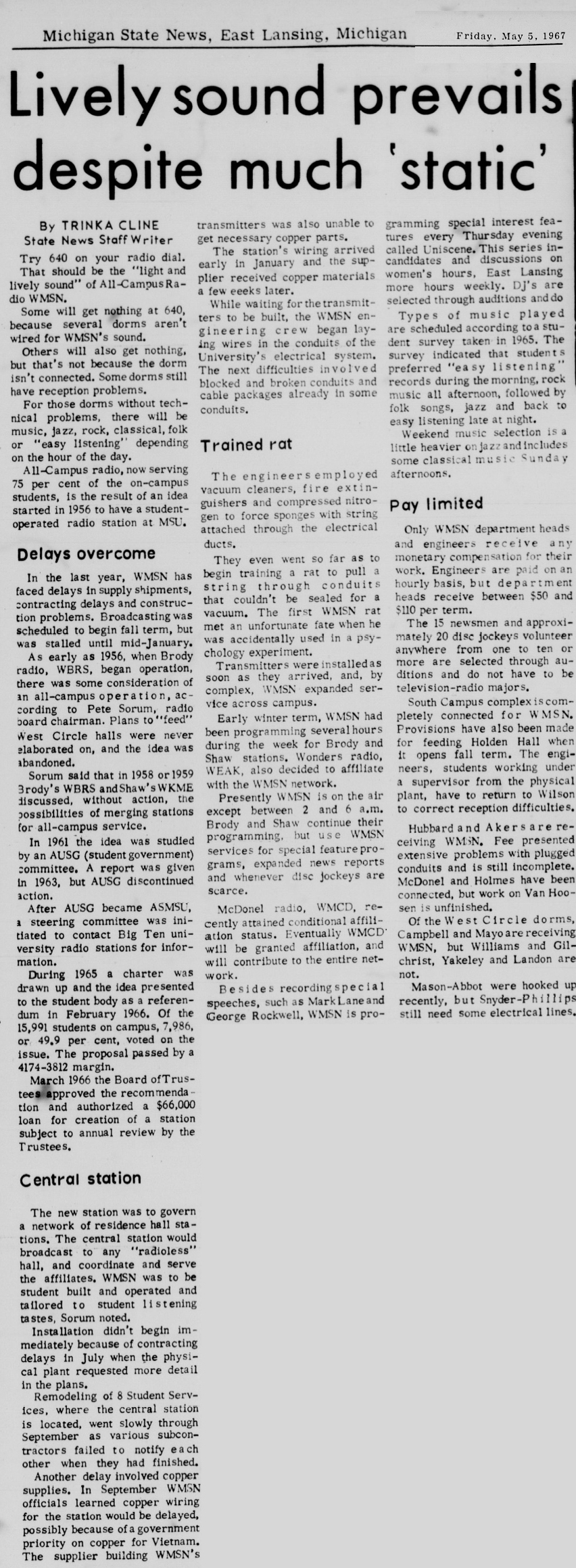Lively sound prevails despite much ‘static’
By Trinka Cline
State news Staff Writer
Try 640 on your radio dial.
That should be the “light and lively sound” of All-Campus Radio WMSN.
Some will get nothing at 640 because several domes aren’t wired for WMSN’s sound.
Others will also get nothing, but that’s not because the dorm isn’t connected. Some dorms still have reception problems.
For those dorms without technical problems, there will be music, jazz, rock, classical, folk or “easy listening” depending on the hour of the day.
All-Campus radio, now serving 75 percent of the on-campus students, is the result of an idea started in 1956 to have student operated radio station at MSU.
Delays overcome
In the last year, WMSN has faced delays in supply shipments, contracting delays and construction problems. Broadcasting was scheduled to begin fall term, but was stalled until mid-January.
As early as 1956, when Brody radio, WBRS, began operation, there was some consideration of an all-campus operation, according to Pete Sorum, radio board chairman. Plans to “feed” West Circle halls were never elaborated on and the idea was abandoned.
Sorum said that in 1958 or 1959 Brody’s WBRS and Shaw’s WKME discussed, without action, the possibilities of merging stations for all-campus service.
In 1961 the idea was studied by an AUSG (student government) committee. A report was given in 1963, but AUSG discontinued action.
After AUSG became ASMSU, a steering committee was initiated to contact Big Ten university radio stations for information.
During 1965 a charter was drawn up and the idea presented to the student body as a referendum in February 1966. Of the 15,991 students on campus, 7.986 or 49.9 percent voted on the issue. The proposal passed by a 4174-3812 margin.
March 1996 the Board of Trustees approved the recommendation and authorized a $66,000 loan for creation of a station, subject to annual review by the Trustees.
Central Station
The new station was to govern a network of residence hall stations. The central station would broadcast to any “radio less” hall, and coordinate and serve the affiliates. WMSN was to be student built and operated and tailored to student listening tastes, Sorum noted.
Installation didn’t begin immediately because of contra ting delays in July when the physical plant required more detail in plans.
Remodeling of 8 Student Service, where the central station is located, went slowly through September as various subcontractors failed to notify each other when they had finished.
Another delay involved copper supplies. In September WMSN officials learned copper wiring for the stations would be delayed, possibly because of a government priority on copper for Vietnam. The Supplier building WMSN’s transmitters was also unable to get necessary copper parts.
The station’s wiring arrived early in January and the supplier received copper materials a few weeks later.
While waiting for the transmitters to be built, the WMSN engineering crew began laying wires in the conduits of the University’s electrical system. The next difficulties involved blocked and broken conduits and cable packages already in some conduits.
Trained rat
The engineers employed vacuum cleaners, fire extinguishers and compressed nitrogen to force sponges with string attached through the electrical ducts.
They even went so far as to begin training a rat to pull string through conduits that couldn’t be sealed for a vacuum. The first WMSN rat met an unfortunate fate when he was accidentally used in a psychology experiment.
Transmitters were installed as soon as they arrived and, by complex, WMSN expanded service across campus.
Early winter term, WMSN had been programming several hours during the week for Brody and Shaw stations.Wonders radio, WEAK, also decided to affiliate with the WMSN network.
Presently WMSN is on the air except between 2 and 6 a.m. Brody and Shaw continue their programming but use WMSN services for special feature programs, expanded news reports and whenever disc jockeys are scarce.
McDonel radio, WMCD, recently attained conditional affiliation status. Eventually WMCD will be granted affiliation and will contribute to the entire network.
Besides recording special speeches, such as Mark Land and George Rockwell, WMSN is programming special interest features every Thursday evening called Uniscene. This series in-candidates (sic) and women’s hours.East lansing more hours weekly (sic). DJ’s are selected through auditions and do (sic)
Types of music played are scheduled according to a student survey taken in 1965. The survey indicated that students preferred “easy listening” records during the morning, rock music all afternoon, followed by folk songs, jazz and back to back easy listening late at night.
Weekend music selection is a little heavier on jazz and includes some classical music Sunday afternoons.
Pay limited
Only WMSN department heads and engineers receive any monitory compensation for their work. engineers are paid on an hourly basis but department heads receive between $50 and $110 per term.
The 15 newsmen and approximately 20 disc jockeys volunteer anywhere from one to ten or more are selected through auditions and do not have to be television-radio majors (sic).
South Campus complex is completely connected for WMSN. Provisions have also been made for feeding Holden hall when it opens fall term. The engineers, students working under a supervisor from the physical plant, have to return to Wilson to correct reception difficulties.
Hubbard and Akers are receiving WMSN. Fee presented extensive problems with plugged conduits and is still incomplete. McDonel and Holmes have been connected but work on Van Hoosen is unfinished.
Of the West Circle dorms, Campbell and Mayo are receiving WMSN, but Williams and Gilchrist, Yakely and Landon are not.
Mason-Abbot were hooked up recently, but Snyder-Phillips still needs some electrical lines.
